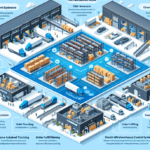Optimizing Warehouse Management with FedEx and Blue Yonder WMS Integration
In the dynamic world of logistics, efficiency is paramount. Effective warehouse management ensures that supply chains operate smoothly, minimizing delays that can disrupt operations. Leveraging technology to optimize shipping processes is essential, and integrating FedEx with Blue Yonder WMS offers significant advantages for warehouse managers.
Importance of FedEx Integration for Enhanced Efficiency
FedEx is renowned for its reliability and extensive global network, making it a preferred shipping carrier for many businesses. Integrating FedEx with Blue Yonder WMS can significantly enhance warehouse efficiency through various features:
- Real-Time Tracking and Visibility: Monitor shipments in real-time to ensure timely deliveries and manage inventory accurately.
- Accurate Shipping Costs: Obtain precise shipping cost estimates, aiding in better financial planning and pricing strategies.
- Automated Processes: Streamline tasks such as label printing and package tracking, reducing manual errors and saving time.
According to a Forbes Technology Council report, integrating advanced shipping solutions can improve warehouse efficiency by up to 30%, highlighting the importance of seamless carrier integrations.
Benefits of Blue Yonder WMS in Supply Chain Management
Blue Yonder WMS is a comprehensive warehouse management system that optimizes the entire supply chain process. Key benefits include:
Real-Time Inventory Visibility
Gain instant insights into inventory levels and movements, enabling informed decision-making regarding stock management and reorder points.
Customizable and Scalable Solutions
Adapt the system to meet the unique needs of your business, ensuring scalability as your operations grow.
Data-Driven Insights
Utilize advanced analytics and reporting tools to assess warehouse performance, identify bottlenecks, and implement improvements.
According to a Supply Chain Digital article, businesses using advanced WMS solutions like Blue Yonder report a 15-20% increase in operational efficiency.
Integrating FedEx with Blue Yonder WMS: A Step-by-Step Guide
Seamlessly integrating FedEx with Blue Yonder WMS involves the following steps:
- Access Shipping Settings: Log in to your Blue Yonder WMS account and navigate to the "Shipping" tab.
- Select Carrier Integration: Click on "Carrier Integration" and choose "FedEx" from the list.
- Enter FedEx Credentials: Provide your FedEx account number, meter number, and API key. These can be obtained by contacting FedEx directly.
- Save and Test Integration: After entering the required information, save the settings and perform a test shipment to ensure the integration functions correctly.
Before initiating the integration, verify that your FedEx account is active and all necessary information is accurate to prevent any disruptions in the shipping process.
Optimizing Shipping Processes with Integrated Systems
The integration of FedEx with Blue Yonder WMS offers numerous opportunities to optimize shipping processes:
Automated Label Printing and Documentation
Automate the generation of shipping labels and necessary documentation, reducing manual effort and minimizing errors.
Enhanced Order Fulfillment
Streamline order processing by automating carrier selection based on predefined criteria such as cost, delivery speed, and reliability.
Improved Cost Management
Utilize accurate shipping cost calculations to optimize pricing strategies and improve overall financial management.
Studies have shown that businesses implementing integrated shipping solutions experience a reduction in shipping errors by up to 25%, as reported by Inbound Logistics.
Enhancing Inventory Control Through Integration
Effective inventory management is crucial for maintaining supply chain efficiency. Integrating FedEx with Blue Yonder WMS enhances inventory control in several ways:
- Real-Time Inventory Updates: Automatically update inventory levels upon shipment and receipt of goods, ensuring accurate stock counts.
- Reduction of Lost Inventory: Track shipments meticulously to prevent misplaced or lost items.
- Optimized Reordering: Utilize real-time data to determine optimal reorder points, preventing stockouts and overstock situations.
According to a Business News Daily article, effective inventory control can lead to a 10-15% reduction in holding costs.
Best Practices for Managing Shipping Orders
To maximize the benefits of integrating FedEx with Blue Yonder WMS, consider the following best practices:
Batch Processing of Orders
Group similar orders together to streamline the picking and packing processes, enhancing overall efficiency.
Utilize Wave Planning
Implement the "Wave Planning" feature in Blue Yonder WMS to schedule shipping orders in optimized batches, reducing processing time and minimizing errors.
Regular Order Tracking and Monitoring
Continuously monitor the status of each shipment using real-time tracking tools to quickly address any delays or issues.
Implement Quality Control Measures
Conduct regular audits of the shipping process to ensure all orders are accurately packaged and labeled, enhancing customer satisfaction.
Adopting these practices can improve order fulfillment accuracy by up to 20%, as highlighted by Supply Chain Dive.
Tracking Shipments Effectively with Integrated Tools
Effective shipment tracking is essential for maintaining transparency and ensuring timely deliveries. Here are some best practices:
- Dual Tracking Numbers: Utilize tracking numbers from both Blue Yonder WMS and FedEx to ensure comprehensive tracking.
- Automated Alerts: Set up automated notifications for delays or changes in shipment status to proactively manage issues.
- Customer Communication: Keep customers informed about their order status and estimated delivery times to enhance satisfaction.
Regular analysis of shipment data can identify trends and areas for improvement, helping to optimize future shipping strategies.
Ensuring all staff are trained in using tracking tools effectively can reduce tracking errors by 15%, as reported by Logistics Management.
Streamlining Returns Management with Integrated Systems
Managing returns efficiently is critical for maintaining customer satisfaction and optimizing inventory levels. Integration between FedEx and Blue Yonder WMS offers several advantages:
- Automated Return Labels: Generate return labels and forms automatically, simplifying the returns process for customers.
- Real-Time Tracking of Returns: Monitor return shipments to manage inventory more effectively and quickly restock items.
- Data-Driven Insights: Analyze return patterns to identify and address underlying issues, reducing future return rates.
Implementing streamlined returns processes can decrease return processing time by up to 30%, enhancing overall operational efficiency.
Future Trends in Supply Chain Management with FedEx and Blue Yonder WMS
The future of supply chain management is poised for significant advancements, driven by emerging technologies:
Artificial Intelligence and Machine Learning
AI and ML will play a pivotal role in predicting demand, optimizing inventory levels, and automating decision-making processes.
Sustainability Initiatives
Businesses will increasingly focus on sustainable practices, such as using eco-friendly packaging, optimizing transportation routes to reduce emissions, and implementing circular supply chain models.
Enhanced Integration Capabilities
Further integration between WMS and various carriers like FedEx will provide even more seamless operations, improving data accuracy and operational efficiency.
Staying abreast of these trends is essential for businesses aiming to maintain a competitive edge and achieve long-term success in supply chain management.
Conclusion
Integrating FedEx with Blue Yonder WMS is a strategic move for warehouse managers seeking to optimize shipping processes and enhance overall efficiency. The integration offers real-time tracking, accurate shipping cost calculations, automated processes, and improved inventory control, all of which contribute to better operational performance and customer satisfaction. By implementing best practices for order management and returns processing, businesses can further capitalize on the benefits of this integration.
As the supply chain landscape evolves, incorporating advancements like artificial intelligence and sustainability initiatives will be crucial. Businesses that leverage integrated systems like FedEx and Blue Yonder WMS are well-positioned to navigate future challenges and capitalize on new opportunities, ensuring sustained growth and success.






















